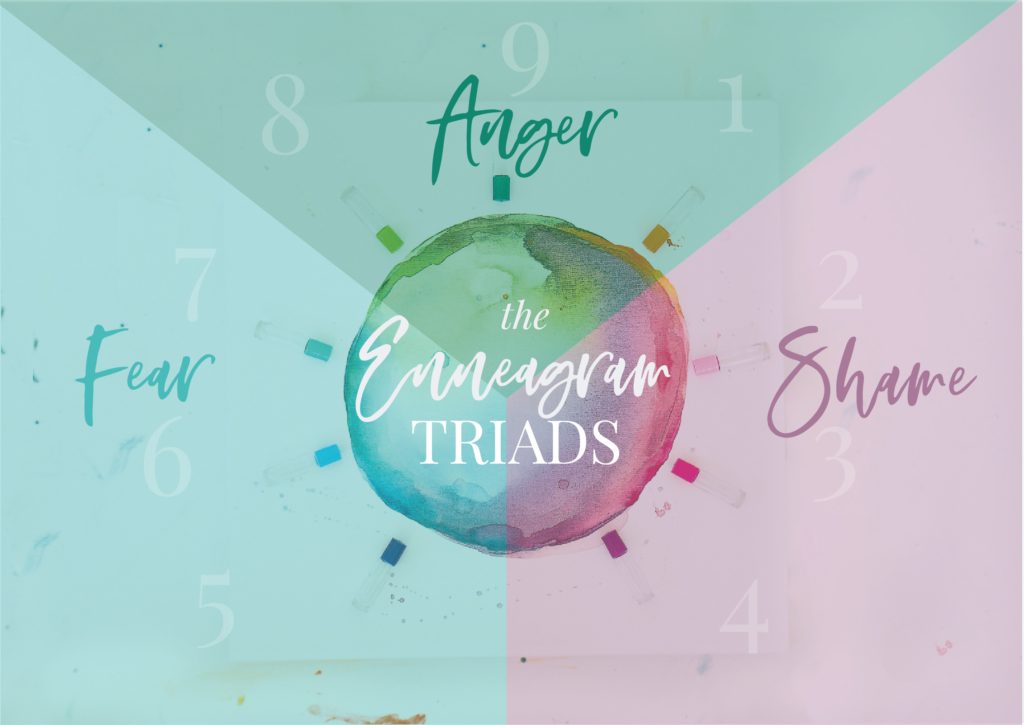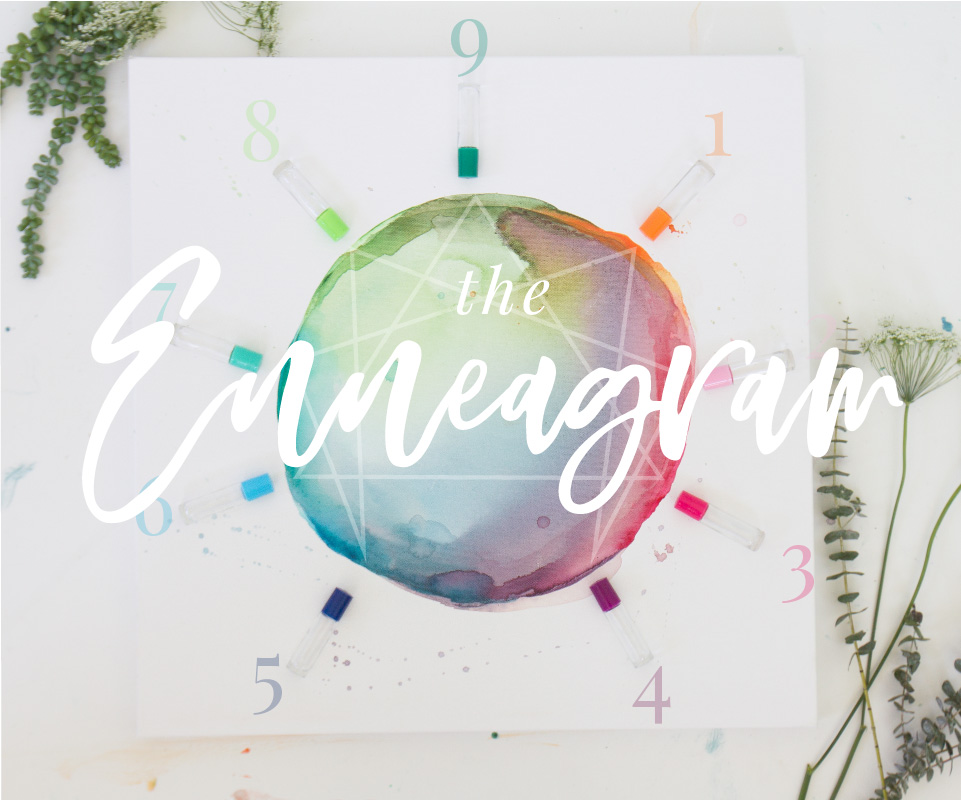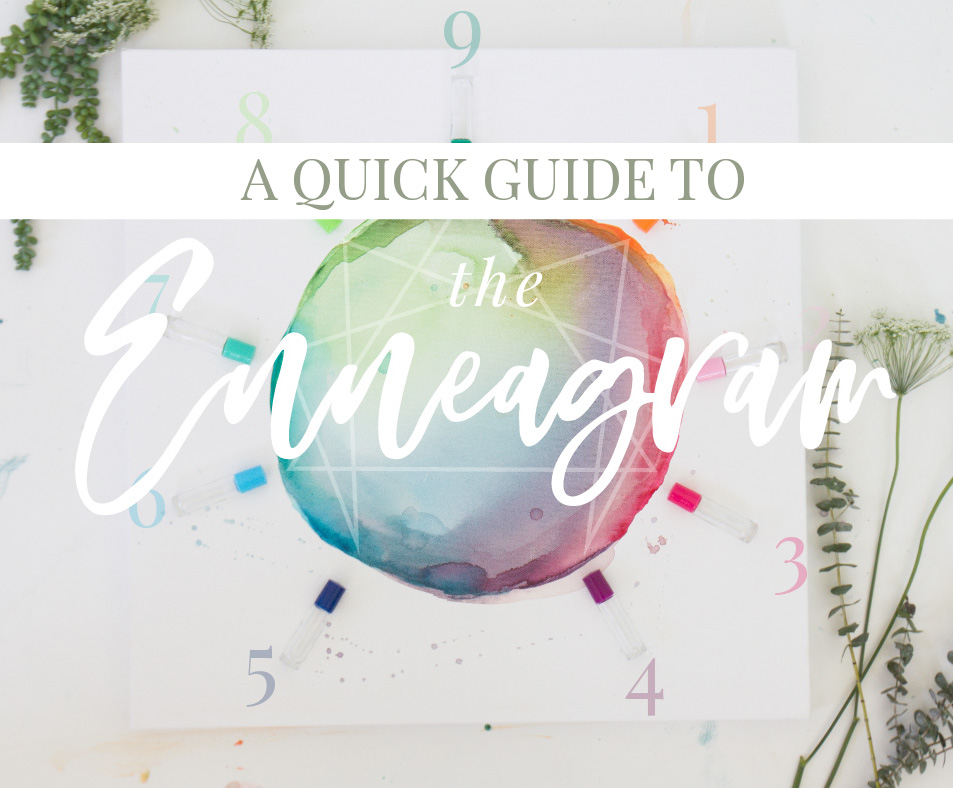
*I am an Enneagram enthusiast. It has impacted my life in profound ways, and I hope you will benefit from its teaching as well. Please always refer to the experts (an Enneagram teacher, certified coach, or counselor) — they know best!*
Like I mentioned in the first post in my Enneagram series, The Enneagram is a personality typology based on people’s motivations. Instead of just telling you HOW you are, it reveals WHY you are the way you are. There are nine personality types in The Enneagram.
The different motivations/types in The Enneagram are referred to by their numbers (“I am a Three”) and oftentimes by a descriptive title (“I am an Achiever.”) Different Enneagram Teachers use different names based on that teacher’s preference, but they’re all similar.
I tend to think of the Enneagram types as colors because although many people are the same number, each person’s motivations play out differently. In color terms, this means all Fours may be blue — but “blue” could be navy, teal, cerulean, sky blue, aqua or midnight. The reason that each person’s number looks different (i.e. not all Threes are CEOs even though all Threes are achievement-oriented) is that the numbers are complex and have many layers. We all begin with the same “color” as determined by our number (blue, e.g.), but then we add other elements to that base. Some of us may add a bit more black or white or green or yellow, and in the end we are our own, unique version of “blue.”
These layers of The Enneagram are:
*Wings
*Arrows
*Dominant Instinct
*Level of Health
I know these terms sound odd, but they offer some great insight into who we are and why we do the things we do. Let’s take a look at the layers of The Enneagram so maybe it will sound less crazy!
*There are a TON of resources out there on all of the following information. I always refer people to The Enneagram Institute because it’s online and comprehensive. MOST OF THE FOLLOWING INFORMATION IS CONDENSED FROM THEIR SITE with a few spins of my own, so please go visit and support them! “The Road Back to You” is a great resource!*
Your Number
There are nine numbers that express the reason WHY you act how you do.
1 (Principled Perfectionist) – principled, purposeful, self-controlled, perfectionistic
2 (Empathetic Helper) – generous, demonstrative, people-pleasing, possessive
3 (Adaptable Achiever) – adaptable, excelling, driven, image-conscious
4 (Creative Individualist) – expressive, dramatic, self-absorbed, temperamental
5 (Independent Investigator) – perceptive, innovative, secretive, isolated
6 (Security-Seeking Loyalist) – engaging, responsible, anxious, suspicious
7 (Enthusiastic Dreamer) – spontaneous, versatile, acquisitive, scattered
8 (Confident Challenger) – self-confident, decisive, willful, confrontational
9 (Easy-Going Peacemaker) – receptive, reassuring, complacent, resigned
Each number has its own strengths and weaknesses (“high sides” and “low sides”).
I feel like it’s important to verbalize that most people only see the low sides of their own number and oftentimes feel that another number’s grass is greener. But, the reality is that we are who we are, and all the numbers’ characteristics are necessary to create a fully-functioning world.
Think of your number as your basic color — your nice, neutral, medium “blue,” for example.

These NUMBERS are “SHADED” (influenced) by WINGS, ARROWS, INSTINCTS, and (most importantly) LEVEL OF HEALTH.
Wings
On either side of your number there are two numbers (234, 918, etc.), which are called “wings.” You most likely will find that you may lean toward one or the other’s characteristics.
For me, as a Three, my wings could be a Two (Empathetic Helper) or Four (Creative Individualist). If you know me even one bit, you automatically know my wing is a Four (so strongly, in fact, that I had to work through whether or not I am a Four — but I’ll post about that at a later date). The shorthand for saying “I’m Three with a Four wing” is simply to write “3w4.” (So, for example, a Nine with a One wing would be a 9w1. You’re smart. You get the idea.)
Now, simply because you have a dominant wing doesn’t mean that you can’t lean both ways. There are times, even though my wing is a strong Four, that I find myself leaning toward a Two (usually trying to help other people with something creative, even when they don’t want the help haha!). Many teachers will say that a balanced individual will feel as if they have two equal wings on either side of their number. However, most people identify strongly with one wing over the other.
That being said, you may not lean toward another number. I have several friends who look on either side of their number and don’t feel a strong identity with either wing. I will say that, in my personal experience, many times I do see characteristics of those friends’ wings in their actions, even when they don’t. So, perhaps, if you don’t feel a strong identity with either wing, consider that maybe you’re more balanced and have a little of each wing (which makes you feel like neither is dominant). Go, you!
Think of your wing as moving you to one side or the other of your color’s spectrum — toward light blue or toward navy.
Arrows (Stress + Security)
Each number takes on characteristics of certain other numbers depending on whether the person is in a situation where they feel STRESSED or SECURE. (Enneagram Teachers refer to the Arrows under all sorts of different names, so even if you see this concept referred to as “Direction of Disintegration” and “Direction of Growth,” for example, don’t be freaked out. It’s all the same stuff.)
This can feel a bit confusing if you’re new to The Enneagram. I think about it like this: You probably know someone who would say, “I am the nicest person you’ll meet. I love everyone! I’m a sweet as pie. BUT if you mess with the people I love, and I will cut you.” Really what this person is saying is, “I’m a Two — I love to help others and live for connecting with people. But when I’m under Stress because you’re messing with the thing that matters most to me in life (my people) I act like an Eight with fierce anger/aggression/dominance.”
In many ways, your Stress Arrow points to the low side of a number that represents the opposite of your natural personality; your Security Arrow points to the high side of a number that reinforces the best of your personality traits.
For me as a Three, my Stress Arrow points to a Nine. As productive + efficiency-minded as I am, when I face something overwhelmingly emotional or uncontrollable cannot do anything other than lay in bed for a day. It literally feels like I’m not myself — yet it doesn’t feel totally foreign, just temporarily “off.” The low side of a Nine is what my close friend calls “sloth-ing” (a term I love and have whole-heartedly adopted). I totally sloth sometimes, even though it’s literally the opposite of my natural personality.
Once you’ve wrapped your head around how the Stress Arrow plays out in your life — there’s more. In theory, since you take on the characteristics of another number when under Stress, you have the ability to access the high or low side of that number. You choose.
So, since one high side of a Nine is the ability to play the mediator, although I don’t naturally take on that role, I am working on trying to access that ability in me when I am under Stress instead of slothing. It’s helpful to realize that, with work, you can be your best under Stress by fighting for that high side. However, I also believe that how healthy your number is (we’ll get to that in a bit) has a profound impact on whether or not you actually feel like you can access that high side while under Stress. (I’m still working on it for sure!)
On the opposite end, as a Three, my Security Arrow points to Six. The high side of a Six is being “fully committed to others.” In the seasons when I’ve felt the most secure in who I am and where I’m going, I’ve found myself with the most peaceful ability to support others around me — particularly when I’m in a healthy Enneagram spot.
Think of your Arrows as adding tones to your color based on whether you feel stressed or secure — making it slightly more warm or cool.
Find your number on the two Arrow charts below. Then click here to read about the characteristics of the numbers you go to under Stress and under Security.
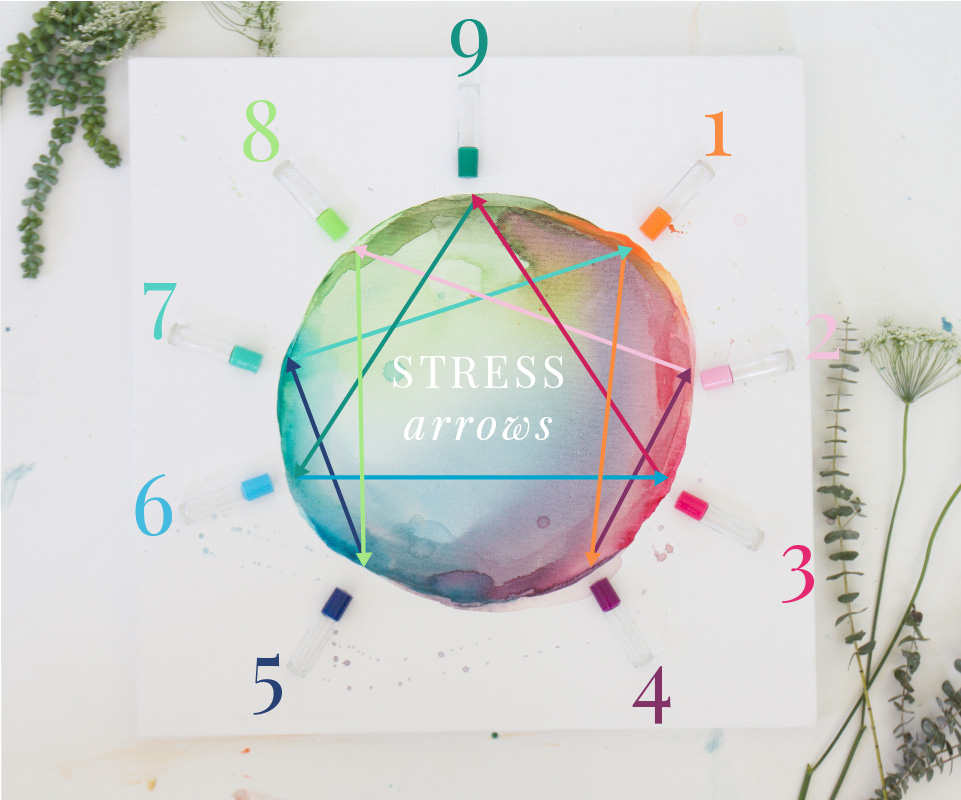
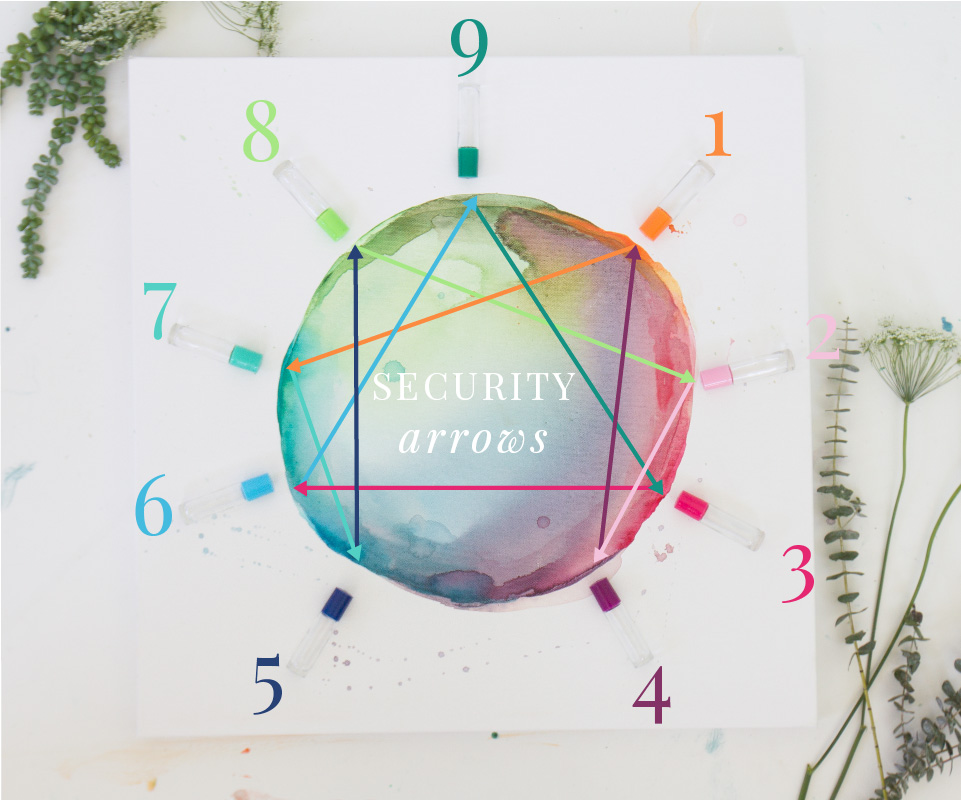
4. Dominant Instinct
Everyone is hard-wired biologically with many basic instincts. The Enneagram recognizes three main instincts that impact your number:
*Self-Preservation
*Chemistry
*Social
Although everyone has all three instincts, people tend to prioritize one of the three. This instinct is your Dominant Instinct — your first priority in life. I like to use a theoretical party as the best way to figure out which instinct you value the most…
Self-preservation in this context means prioritizing the preservation your self, your body, your life and your functionality. Self-Preservation folks’ main thought is “Do I have enough [energy/money/health/stuff] to go the distance?”
In the party scenario, if, as the event went on late into the night, you excused yourself because you “always go to bed by ten because you need at least eight hours of sleep, and it’s 9:30 ohmygosh,” you may identify with the Self-Preservation Instinct. Self-Preservation folks will not sacrifice their own needs just to stand around and chat at a party. People who prep or hoard or spend lots of time working on their health might also fall under this category.
Chemistry refers to the intensity of experiencing things around us, about connection. (“Chemistry” as my own personal term because this is my own Instinct, even though the proper term is “Sexual” — which is, well, awkward, haha!) Technically the Chemistry Instinct is the focus of “for extending ourselves in the environment and through the generations,” to which most people (including myself) respond: HUH?
In the party scenario, it means that you are seeking out individuals with whom you have, well, good chemistry. You are happiest at a party if the energy is good and everything’s “bumping.” You’d probably prefer to leave the party on a high note rather than be the last one there to watch the lights come on and the magic fade. No one likes a dud of a party, but those of us with the Chemistry Instinct seek out those relationships and situations where everything just clicks.
Social is the desire “to create long-reaching, large networks of connectivity.” (Read: herd mentality.) People with this Instinct may value having a lot of relationships that are longterm, even if they’re not the deepest or closest or perfect fit.
At the party, the Social Instincts people make sure to talk to everyone and will definitely be the last one to go home! If you still casually keep up with friends from long ago despite being far away and inconvenient, you probably are a Social Instinct. The same thing goes if you find yourself as a part of many different social circles instead of one tight-knit group.
Once again, the cool thing is that your number influences the way you approach your Dominant Instinct. Combining your Enneagram type with your Dominant Instinct produces a much more specific portrait of your personality, or Subtype. As a Three with a Chemistry Instinct, I am always looking for creative projects to work on with a Dream Team. Your specific number combined with your specific Instinct will look completely different!
Think of your Dominant Instinct as adding vibrancy to your color — making it more muted, more intense, or more mid-range.
5. Level of Health
Once you’re officially obsessed with The Enneagram (it will happen), you’ll most likely run into other people with your same number. You might think, “I know we’re the same number, but they just seem better somehow…” Most likely, you’re interacting with someone who has good Enneagram health.
Just like your physical body, your mental/spiritual self has a particular Level of Health. Everyone falls somewhere on a continuum of healthy —> average —> unhealthy. The interesting thing is that each number shows different characteristic under the Levels of Health (also called “Levels of Development”). The healthiest Seven is going to look totally different than the healthiest Four, despite their Level of Health being the exact same. Because they’re totally motivated by different things!
If you want to be the best version of yourself (the healthiest version of your number), I believe you have to first know where you land on the health spectrum + then work toward a higher level. The Enneagram Institute actually breaks down the Levels of Health/Development into nine segments for each number. I found this profoundly helpful in giving myself an honest evaluation of where I landed on the Three spectrum. I literally found adjectives people had used to describe me (good and bad) to find my starting point. I would highly recommend doing the same for yourself.
It’s also important to note that a person typically lands somewhere on the spectrum overall, but you may feel like you bounce around the continuum a bit (even daily). I mean, no one has an even-keeled, uneventful life all the time! And, as you’re working toward being the healthiest version of you, it’s not necessarily a straight line. Expect some zigzagging — life is messy after all!
Think of your Dominant Instinct as the pigment/opacity of your color — the quality of how transparent (weak) or opaque (strong) it is.
{I know what you’re probably thinking: Great! I want to be a healthier version of my number. But HOW? I promise we’ll talk a little bit more next week on Instagram and here about each number and some ways you can begin to work toward being the healthiest you possible!}
But before we get there, in my next post, we’ll talk about how the numbers are related to one another in “The Triads.”
